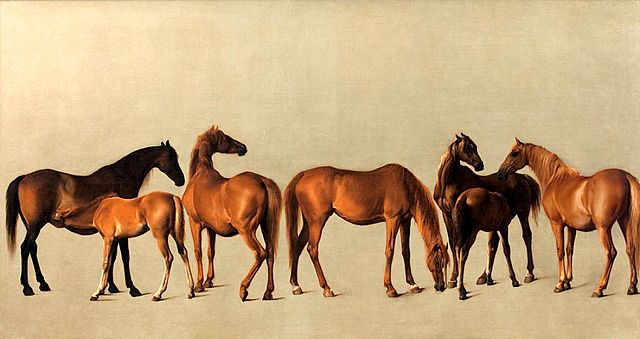George Stubbs was an English painter, best known for his paintings of horses. Self-trained, Stubbs learnt his skills independently from other great artists of the 18th century such as Reynolds and Gainsborough. Stubbs' output includes history paintings, but his greatest skill was in painting animals, perhaps influenced by his love and study of anatomy. His series of paintings on the theme of a lion attacking a horse are early and significant examples of the Romantic movement that emerged in the late 18th century. He enjoyed royal patronage. His painting Whistlejacket hangs in the National Gallery, London.
A self-portrait by George Stubbs
The Milbanke and Melbourne Families (ca. 1769), oil on canvas, 97 x 149 cm., National Gallery
Whistlejacket (ca. 1762), oil on canvas, 292 x 246.4 cm., National Gallery
Painting of a kangaroo, 1772
Whistlejacket is an oil-on-canvas painting from about 1762 by the British artist George Stubbs showing the Marquess of Rockingham's racehorse approximately at life-size, rearing up against a plain background. The canvas is large, lacks any other content except some discreet shadows, and Stubbs has paid precise attention to the details of the horse's appearance. It has been described in The Independent as "a paradigm of the flawless beauty of an Arabian thoroughbred". The Fitzwilliam family, heirs of the childless Rockingham, retained the painting until 1997 when funding from the Heritage Lottery Fund allowed the National Gallery, London to acquire it for £11 million.
Whistlejacket
Stubbs's Molly Long-legs with her Jockey (1761–62), a more typical racehorse portrait (101 × 127 cm)
Mares and Foals without a background, other Rockingham horses painted by Stubbs on his visit in 1762. Whistlejacket was in the pair piece showing stallions.
George Stubbs, A Lion Attacking a Horse, also painted in 1762; one of many treatments of this subject by Stubbs







